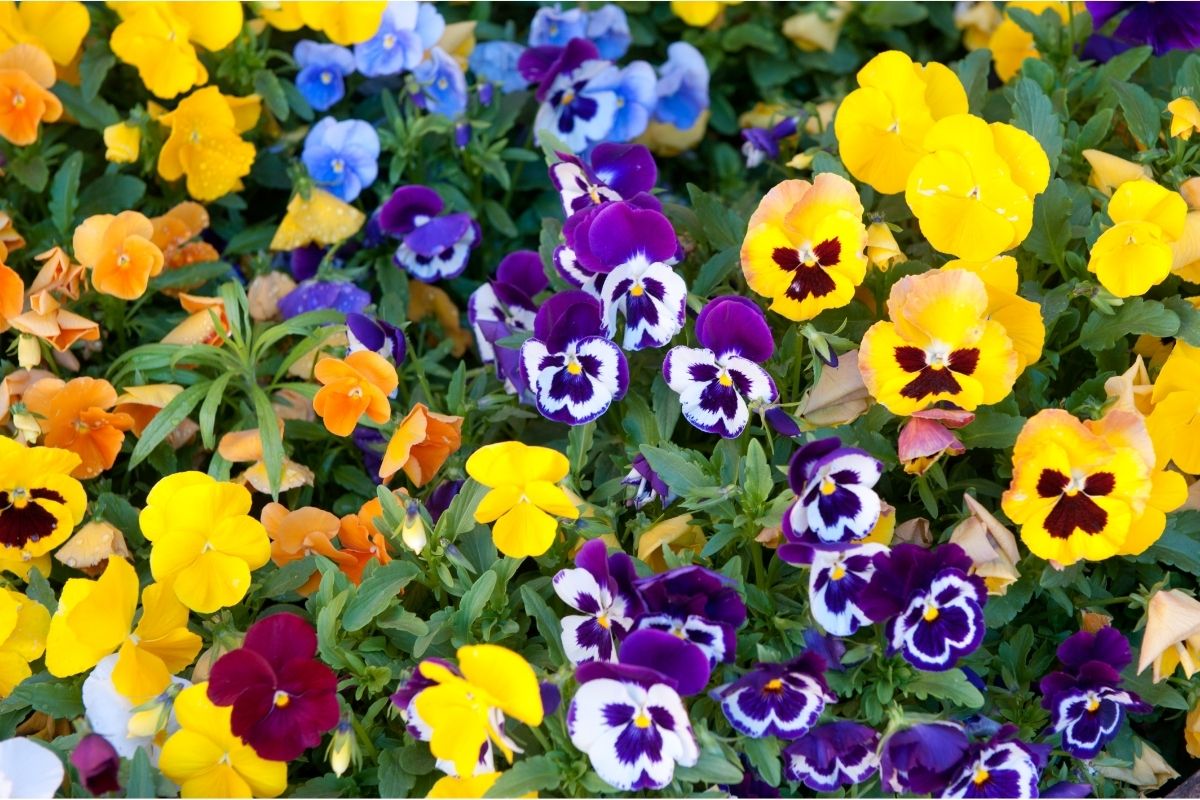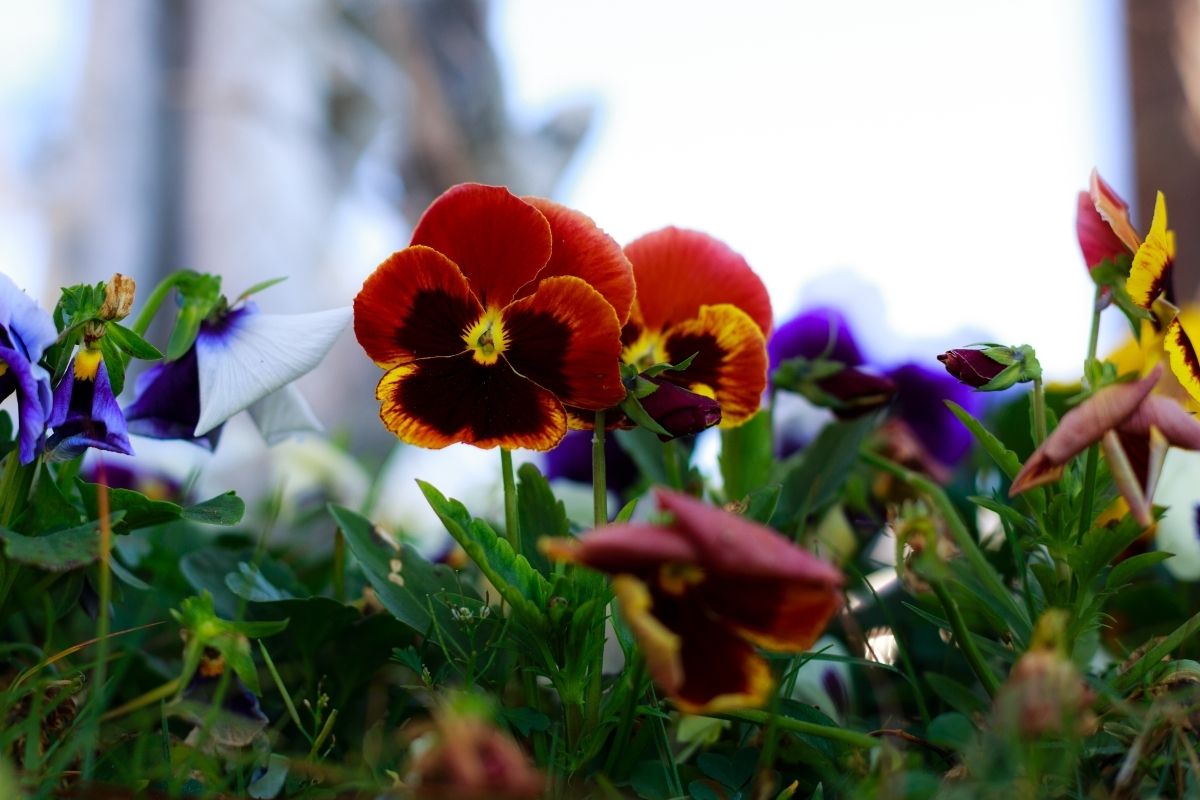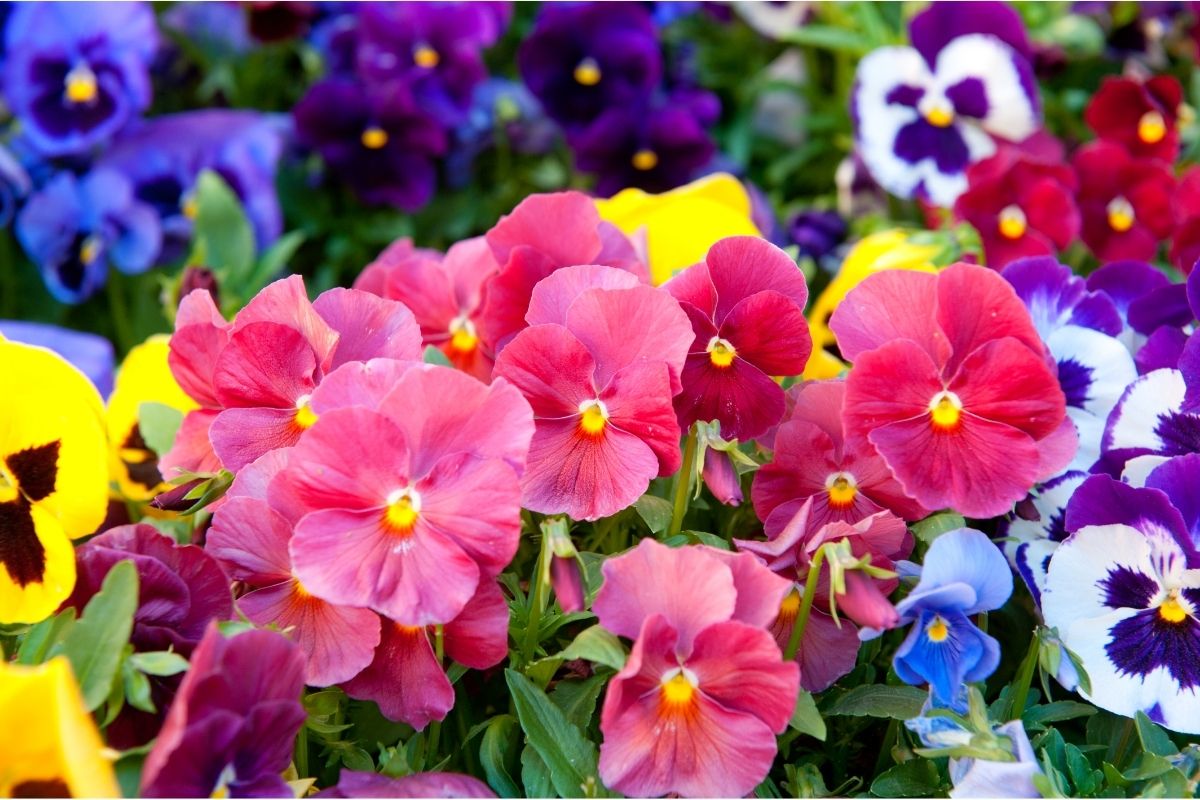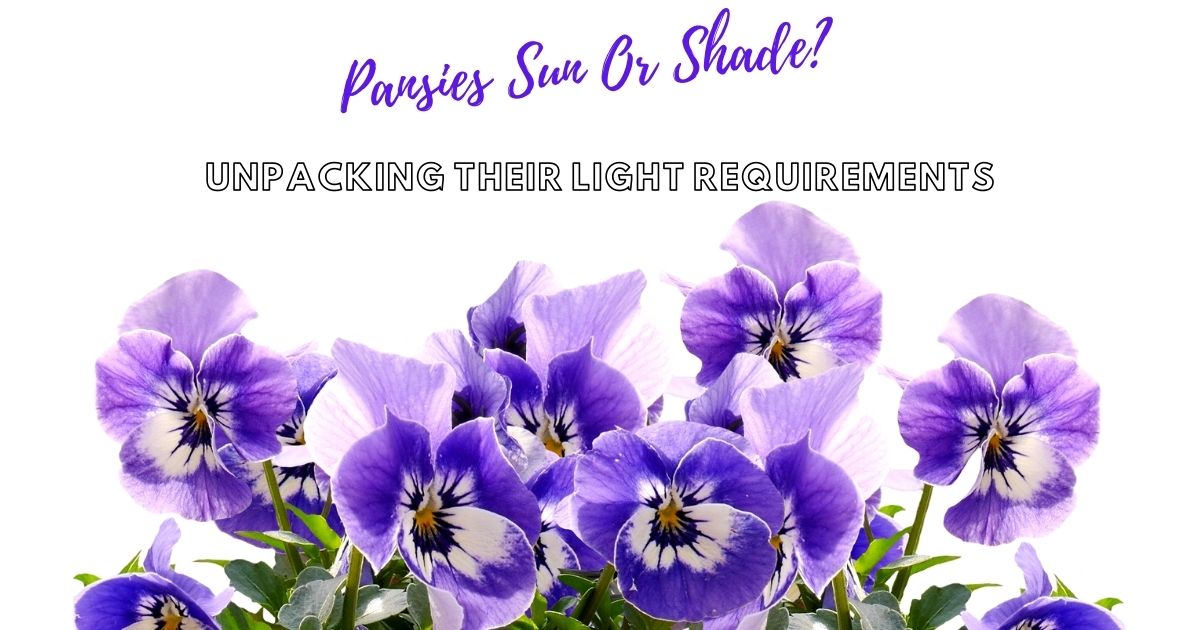What are Pansies?
Pansies are colorful garden flower plants with “faces.” Many people find them great for both spring and fall gardens. Are pansies sun or shade plants? They grow well in the shade or cool areas.
Pansies are always the best in the popularity race for flowers. They’re ideal for new gardeners, rewarding even the most basic efforts with a long season of brilliant blooms. They are excellent plants.

What do Pansies Look Like?
Pansies have a heart shape with overlapping petals and have one of the most diverse color and pattern palettes. They’re a go-to flower for reliable color practically year-round in certain regions, suitable for containers, borders, and ground cover.
Pansies look lovely when you plant them with cool-season flowers like violas, primroses, trailing lobelia, and sweet alyssum in the monochrome or mixed color scheme.
Do Pansies Like Sun or Shade?
Pansies thrive in the spring and fall when the nights are cool and the days are warm. Even frosts and freezes do not affect the blooming of these flowers.
In certain mild southern winters, fall-planted pansies flourish. Fall-planted pansies bloom in the fall, providing bright blossoms in the fall, and then disappear for the winter, only to emerge in the spring to bloom with daffodils, early tulips, and other spring-blooming flowers.
With the arrival of summer heat, these flowers progressively shrink and perish as the temperatures rise. Pansies that you plant in the fall have larger, more frequent spring blooms and may not tolerate the sun, but those in the spring may tolerate the heat better.
In the end, these flowers prefer to be in the shade or in cool temperatures. Because of the high temperatures, most of them perish during the hot summer months, even when kept out of direct sunlight.
Growing Pansy Under Sun Or Shade
A cooler environment is ideal for pansies. As a result, you should plant them in the spring or fall. Plant them in well-drained, high-organic-matter soil.
Planting in the Spring
Pansies grow very well when the soil temperature is between 45 to 65 degrees Fahrenheit (7 to 18 degrees Celsius). Spring planting occurs around the same time as your usual early vegetable planting. The pansy displays in northern gardens last longer than in southern gardens when summer arrives rapidly, and pansies leave soon.
Nonetheless, it’s critical not to plant too early. The pansies are under a lot of stress when there is too much cold, which reduces growth, poor flowering, and discoloration. In the spring, use a soil thermometer to see if the temperature is suitable for planting. You can purchase the thermometer at a local hardware or garden store.
Planting in the Fall
Pansies can also be planted in the fall, once the summer sun has subsided and the earth is dry. It would be beneficial to give your pansies enough time to grow their roots before winter. Your pansies will be able to survive the winter if they have a strong root system. The cold resistance of small flowering pansies is the best.
Are Pansies Perennials?
You can treat them as annual or perennial, depending on your climate. On the other hand, most gardeners consider this plant a yearly one because it thrives more in mild temperatures and becomes too lanky in the summer heat. There hasn’t been much success in developing heat-tolerant pansies that can withstand the heat.
In the winter, though, pansies are surprisingly hearty. They’ll withstand a frost and even recover from single-digit temps. The plants will often stay alive to bloom again if the blossoms wither in the cold, making them a great flowering plant for fall and early winter color.
Proper Pansies Care
Pansies are the clear winners in the popularity race for flowers. They’re ideal for new gardeners, rewarding even the most basic efforts with a long season of brilliant blooms.
There’s a pansy to suit your taste, whether you want a red pansy for fall, a white pansy for winter, a black pansy for drama, a yellow pansy for fragrance, a pink pansy for beauty, or a variety of other bright pansy kinds.
This is a plant that appeals to a wide range of people. Pansies are viola plants in the botanical sense. The scientific name is Viola x wittrockiana, but all you have to do at the garden center is ask for pansies.
Planting Ideas and Growing Tips for Fall Pansies
Fill containers and planting areas with beautiful pansies to welcome the cooler season. Although pansies are short-lived perennials, most gardeners treat them as annuals, growing them in containers or creating dynamic displays in landscape beds. Find out everything you need to know about raising pansies.
Best Season for Pansies
Pansies endure the winter in these mild climates without missing a blossoming beat. Over the winter, gardeners can grow a crop of bright pansy blooms in cooler temperatures.
Plants may go dormant throughout the coldest months of the year, but they might reawaken in the early spring as the temperature rises. Plant breeders strive to generate new types with heat tolerance that can deliver summer blooms. Viola plants are more heat tolerant than pansies.
Pansiola is a hybrid between a pansy and a viola, a pansy cousin that can withstand heat. Pansiola plants produce enormous, pansy-like flowers on trailing plants, making them ideal for hanging baskets and containers.
Planting Suggestions for Pansies
One of the best low-maintenance personalities is that of Pansies. They’ll thrive if you provide them with the right conditions.
- Light: Pansies need around six hours of sunlight per day to thrive. Protect plants from full sun during the hottest portion of the day in the hottest regions. The formation of flowers can slow due to too much heat. Cool wave, a new trailing pansy variety, requires at least six hours of full sun to flower well. Consider planting pansies beneath deciduous trees that have lost their leaves for the season, allowing sunshine to reach the soil.
- Soil: Organic matter-rich soil is ideal for pansies. Fill planting beds with finished compost, leaf mold, bark fines, or other locally available organic matter. Choose a packaged commercial planting mix labeled for use in containers if you’re planting in pots.
- Fertilizer: Pansies respond nicely to a slow-release fertilizer that you put into the soil at planting time. To keep pansies from expanding in hotter climates, avoid feeding them high-nitrogen fertilizer in September. You can find slow-release fertilizer in most commercial soil mixes for pots. Apply liquid plant food to pansies in containers four weeks after planting and whenever you cut plants back to stimulate additional flowers.
- Pests: Pansies are pest-free for the most part when growing. Aphids may attack in the early spring on rare occasions. You can remove the aphids with an insecticidal soap spray. Pansies are most vulnerable to slugs, especially early and late in the growing season. To get rid of slugs or snails, use slug bait (search for eco-friendly varieties) or traps.
Other types of pests and diseases that can affect pansies are:
- Crown rot and root rot
- Downy mildew
- Gray mold
- Mosaic viruses
- Powdery mildew
- Rust
- Spot anthracnose
- Slugs, snails, and aphids
- Viruses that cause mosaics
When Should You Plant Pansies?
You can plant pansies early in the spring or late in the fall. Starting pansies from seed can be difficult; it’s much easier to acquire mature plants from a local nursery. You’ll also get blooms a lot faster.
However, for early spring and summer blossoming, plant pansy seeds inside late winter, 8 to 10 weeks before the final spring frost. Alternatively, sow seeds in the late summer for fall and winter blooming. Pansy seeds might take a long time to germinate; this can be from 1 to 3 weeks, depending on soil temperature.
When the ground is usable in the spring, plant pansy plants thrive in soil temperatures ranging from 45 to 65 degrees Fahrenheit (7 to 18 degrees Celsius). Pansies may withstand a light frost after planting, but don’t place them in the ground if temperatures are consistently below freezing point.
Purchasing Pansies
Choose plants with rich green foliage that are compact rather than leggy. Remove the plant from its container to inspect the roots before purchasing. Healthy roots are white, and a proper ratio of roots and soil should be visible. Plants that are leggy or root-bound have a difficult time establishing themselves.
Purchase pansies in larger cell packs or 3 to 4 inches (7.6 to 10.2 centimeters) pots, as landscapers do. Because these plants have more extensive root systems, they establish and take off more quickly after you plant them. You want larger plants for fall planting.
Because your pansies won’t grow as much once the cold weather arrives for the winter, it’s best to start with larger plants so they can full out before the midwinter slowdown.
You can start pansies from seed, and you require 10 to 12 weeks to grow them from seed to plant. In the fall, southern gardeners should sow seeds in beds outside. Northern gardeners should start seeds indoors in the early spring or experiment with winter growing methods. In terms of sowing depth and thinning, follow the instructions on the seed packet.
Secrets to Success With Pansies
It’s all about the temperature. Nights in the 40s and days in the 60s are ideal for growing pansies. Warmer temperatures cause lanky, floppy stem growth and fewer flowers, so pulling and composting pansies as summer heat hits is brilliant.
Plant as soon as possible. Plant winter pansies as early as possible in the fall, at least six weeks before your first frost date, for the best results. If the soil temperature is too cold when you plant, the roots will be dormant, resulting in stunted plants with few flowers. Pansies are less likely to survive the winter in these conditions.
Pansies with small flowers do better in winter displays than those with huge flowers. Plant pansies up to a month before the latest frost date in your area when planting in the spring. Keep them squeaky clean.
Remove wasted blooms regularly to encourage the formation of new ones. Pansy plants die quickly if left to set seed. To rapidly remove excess flowers, give plants a gentle cut with scissors.
Make preparations ahead of time. Sketch your concept on paper to make an eye-catching landscape planting. Most pansies require 6 inches (15.2 centimeters) between plants, but trailing varieties may need more. Look for a “formula mix,” a bespoke color blend created by plant breeders, for can’t-miss color combinations.
Some of the blends contain pastel colors, while others feature vibrant hues. It’s not difficult to discover one that you like. Using a formula mix is that all of the pansies grow at the same rate and to the same height, making it simple to create beautiful beds.

How Long Do Pansies Last?
If you reside in a warmer part of the country, you may already know that you can plant pansies in the fall, and they will thrive and bloom throughout the winter and into the spring. On the other hand, pansies are hardy in sections of the northern United States and southern Canada and can be overwintering as far north.
Pansies can endure up to eight months if you plant them in the fall, from September to April or May, offering vivid blooms for much of that time. They aren’t beautiful in the dead of winter, but their spring blossoms are considerably more impressive after the plants have been in the ground since the fall.
Varieties Of Pansy
Pansies will be your go-to flower if you want a variety of hues but still want to grow the same plants with the same cohesion. Regardless of the hue, they are identical in size and patterns.
- Bingo series: There are 14 hues available for this large-flowered variety, including burgundy and pastel blue. The blooms arrive earlier than those of the popular Majestic Giants variety.
- Bolero type: The flowers are big, ruffled, and semi-double. This variety thrives in the fall and spring.
- The cool wave: These fast-growing robust flowers spread like cool wave petunias. For container plants, they make good spillers.
- Joker type: The faces of this species are bicolored and complementary in color.
- Freefall habits: these day-neutral, trialing plants are ideal for containers or gardens where no other plants grow. As their name implies, they are free to explore the region or spill from the containers.
- Princess type: This variety has tiny flowers and a compact growth habit. It comes in monochromatic tones with yellow cores, ranging from cream to deep purple.
How to Use Pansies
If the pansy blooms do not have chemicals, they’re entirely edible. They’re a great complement to cakes, tea sandwiches, and salads. Freeze a bloom in an ice cube.
Plant pansies in containers alongside grasses or other spring bloomers such as flowering stock, primrose, or sweet alyssum. You can also use them to create edging for walkways and planting beds. Pansies look fabulous with spring bulbs, creating a vibrant ground cover that can help hide fading bulb leaves.
When to Plant Pansies Outside
Pansies have an astonishing ability to survive the bitter cold of winter and emerge victorious in the spring. They can only be resilient if you plant them at the right time and in the right place. Planting too soon when the weather is too hot causes the plant to turn yellow, leaving it subject to frost damage or insect and disease infestation.
Planting pansies outside when the soil temperature falls below 45 degrees Fahrenheit (7.2 degrees Celsius.) causes the plant’s roots to shut down, resulting in few, if any, blossoms. To determine when to plant pansies in your location, use a soil thermometer to check the temperature of your soil.
Consider your USDA plant hardiness zone when deciding whether to plant pansies. In general, late September and late October. Water them thoroughly shortly after planting to get a good start on pansies.
Water the plant’s soil only; do not damp the blossoms or leaves, as this could attract illness. In the winter, a layer of mulch that you place on the pansy plant bed will assist avoid any harm from the cold.
What to Do With Pansies in the Summer
Is it possible to grow pansies in the summer? This is an excellent question for anyone who adores these bright, vivid blooms. There’s a reason they’re one of the first annuals to hit the market in the spring and then again in the fall. They thrive in the cooler months, but how and when you enjoy them is dependent on the type and your climate.
It depends on where you live, your environment, and the kind you choose whether or not you can grow summertime pansies in your garden. Although specific cultivars have developed heat tolerance pansies, they remain not fond of extreme temperatures.
Majestic giant, springtime, maxim, padparadja, matrix, dynamite, and universal are some variations. Even with these heat-tolerant pansies, they may suffer and wilt if summer temperatures consistently exceed 70 degrees Fahrenheit (21 degrees Celsius).
Give them moderate shade, fertilize lightly, and deadhead during the warmer months to get the most blooms.
Summer is the most significant time to grow pansies and get them to bloom if you live in a cooler location where the warmest temperatures of the year are at or below 70 degrees Fahrenheit (21 degrees Celsius). It’s also better to plant pansies in the winter if you reside in a warm climate.
Will Pansies Thrive in the Summer Heat?
Pansies are a typical cool-weather flower grown as an annual in most regions. Gardeners in warmer and more temperate areas, such as sections of California, can grow them all year. It is more common to cultivate them during the cooler months in regions where the climate is more dramatic with the seasons.
In general, these flowers do not wish to bloom in hot weather. For example, if you live in the Midwest, you will most likely plant annual pansies in beds or containers in early April.
They will bloom beautifully until the summer heat sets in, at which point the plants will wilt, sag, and stop flowering. But if you keep them going, you’ll have blooms again in the fall as the weather cools down.
How To Get Your Pansies Ready For Winter
Planting your pansies at the right time is crucial for their winter survival. The temperature of the soil must not be very hot or cold. Can Pansies Survive Frost?
Pansies become stunted when temperatures drop, with pale foliage and fewer flowers. The cold stresses the developing root system, preventing it from effectively absorbing nutrients. In the meantime, pansies you plant while the weather is still warm will become yellow.
They also have inferior flowering qualities and are more susceptible to pests and frost damage. If you live in icy areas, you should ensure that the pansies survive the cold. You can accomplish this by covering the plants in dry winter mulch.
Cover your garden bed with 2-4 inches (5-10 centimeters) of pine straw. The mulch helps keep the heat in the soil and reduces the amount of time for exposure to the chilly breeze. After the winter season, gently remove the pine straw. You can also cover your plants with a special frost protection blanket. It’s also crucial to select healthy seedlings.
Plants with a healthy root system grow quickly, essential for winter survival. Another thing to think about is drainage. Saturated soil limits their ability to grow over the winter, so make sure they’re in a well-drained place.

Do Pansies Come Back Every Year?
“Are pansies annuals or perennials?” is a frequently asked question. Once again, the answer is dependent on your geographic location. Pansies develop in different ways depending on the zone. Typically, you grow pansies as annuals. Annual plants grow and flower for only one season, whereas perennial plants grow and flower year after year.
It can behave like an annual, a perennial, or a perennial, depending on where you live and the type of pansy you plant. Pansies are biennials in their natural habitats. In the first year, the leaves and the blooms will appear in the second year. Winters in the Midwest and summers in the South may be too harsh for biennial pansies.
Even in zones where they are officially perennials, they are short-lived, and many of them decline after their first year of flowering. Biennial pansies can live all year on the West Coast in warm climates like Southern California, with new plants returning the next season to flower and complete their growing cycle.
